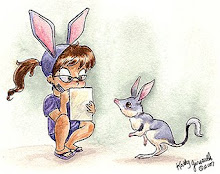 Long-beaked echidnas look rather different than the short-beaked ones most people are familiar with. I tried to give it short fur, without many individual brushstrokes. I also put some purple and blue in the coat, which didn't show up very well in the scan. Incidentally, I painted this partially in the dark due to the power being out.
Long-beaked echidnas look rather different than the short-beaked ones most people are familiar with. I tried to give it short fur, without many individual brushstrokes. I also put some purple and blue in the coat, which didn't show up very well in the scan. Incidentally, I painted this partially in the dark due to the power being out.And with this picture, I've finished the ten focus species for 2007, in the last 2 hours of 2007! I hope to begin to paint the remaining animals on the 100 list. I'll have to see if there is a list of focals for 2008. This has been a fun project; I enjoyed learning about all of these species, and at the same time trying out different art techniques and poses.





















